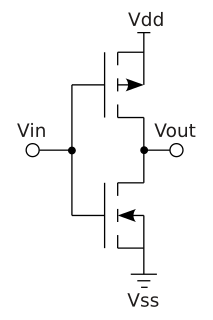
The metal–oxide–semiconductor field-effect transistor (MOSFET, MOS-FET, or MOS FET), also known as the metal–oxide–silicon transistor (MOS transistor, or MOS), is a type of field-effect transistor that is fabricated by the controlled oxidation of a semiconductor, typically silicon. It has an insulated gate, whose voltage determines the conductivity of the device. This ability to change conductivity with the amount of applied voltage can be used for amplifying or switching electronic signals. It was invented by Egyptian engineer Mohamed M. Atalla and Korean engineer Dawon Kahng at Bell Labs in November 1959. The MOSFET is the basic building block of modern electronics, and the most widely manufactured device in history, with an estimated total of 13 sextillion (1.3 × 1022) MOSFETs manufactured between 1960 and 2018.
Transistor–transistor logic (TTL) is a logic family built from bipolar junction transistors. Its name signifies that transistors perform both the logic function and the amplifying function ; it is the same naming convention used in resistor–transistor logic (RTL) and diode–transistor logic (DTL).

Low-voltage differential signaling, or LVDS, also known as TIA/EIA-644, is a technical standard that specifies electrical characteristics of a differential, serial communication protocol. LVDS operates at low power and can run at very high speeds using inexpensive twisted-pair copper cables. LVDS is a physical layer specification only; many data communication standards and applications use it and add a data link layer as defined in the OSI model on top of it.

The 7400 series of integrated circuits (ICs) are the most popular logic families. In 1964, Texas Instruments introduced the first members of their ceramic package SN5400 series transistor–transistor logic (TTL) logic chips, later a low-cost plastic package SN7400 series was introduced in 1966 which quickly gained over 50% of the logic chip market, and eventually becoming de facto standardized electronic components. Over the decades, many generations of pin-compatible descendant families evolved to include support for low power CMOS technology, lower supply voltages, and surface mount packages.
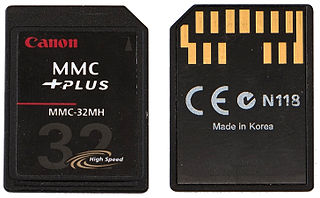
MultiMediaCard, officially abbreviated as MMC, is a memory card standard used for solid-state storage. Unveiled in 1997 by SanDisk and Siemens AG, MMC is based on a surface-contact low pin-count serial interface using a single memory stack substrate assembly, and is therefore much smaller than earlier systems based on high pin-count parallel interfaces using traditional surface-mount assembly such as CompactFlash. Both products were initially introduced using SanDisk NOR-based flash technology. MMC is about the size of a postage stamp: 24 mm × 32 mm × 1.4 mm. MMC originally used a 1-bit serial interface, but newer versions of the specification allow transfers of 4 or 8 bits at a time. MMC can be used in many devices that can use Secure Digital (SD) cards.
High-speed transceiver logic or HSTL is a technology-independent standard for signaling between integrated circuits. The nominal signaling range is 0 V to 1.5 V, though variations are allowed, and signals may be single-ended or differential. It is designed for operation beyond 180 MHz.
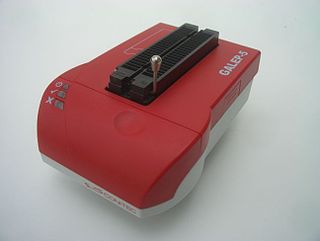
A programmer (hardware), device programmer, chip programmer, device burner, or PROM writer is a piece of electronic equipment that arrange written software to configure programmable non-volatile integrated circuits, called programmable devices. The target devices include; PROM, EPROM, EEPROM, Flash memory, eMMC, MRAM, FeRAM, NVRAM, PLD, PLA, PAL, GAL, CPLD, FPGA, and MCU. These are terminologies in the field of computer hardware.
In computer engineering, a logic family may refer to one of two related concepts. A logic family of monolithic digital integrated circuit devices is a group of electronic logic gates constructed using one of several different designs, usually with compatible logic levels and power supply characteristics within a family. Many logic families were produced as individual components, each containing one or a few related basic logical functions, which could be used as "building-blocks" to create systems or as so-called "glue" to interconnect more complex integrated circuits. A "logic family" may also refer to a set of techniques used to implement logic within VLSI integrated circuits such as central processors, memories, or other complex functions. Some such logic families use static techniques to minimize design complexity. Other such logic families, such as domino logic, use clocked dynamic techniques to minimize size, power consumption and delay.
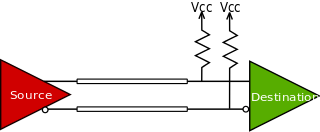
Current mode logic (CML), or source-coupled logic (SCL), is a differential digital logic family intended to transmit data at speeds between 312.5 Mbit/s and 3.125 Gbit/s across standard printed circuit boards.
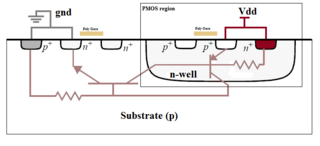
A latch-up is a type of short circuit which can occur in an integrated circuit (IC). More specifically it is the inadvertent creation of a low-impedance path between the power supply rails of a MOSFET circuit, triggering a parasitic structure which disrupts proper functioning of the part, possibly even leading to its destruction due to overcurrent. A power cycle is required to correct this situation.
Gunning transceiver logic (GTL) is a type of logic signaling used to drive electronic backplane buses. It has a voltage swing between 0.4 volts and 1.2 volts—much lower than that used in TTL and CMOS logic—and symmetrical parallel resistive termination. The maximum signaling frequency is specified to be 100 MHz, although some applications use higher frequencies. GTL is defined by JEDEC standard JESD 8-3 (1993) and was invented by William Gunning while working for Xerox at the Palo Alto Research Center.

An open collector is a common type of output found on many integrated circuits (IC), which behaves like a switch that is either connected to ground or disconnected.
In digital circuits, a logic level is one of a finite number of states that a digital signal can inhabit. Logic levels are usually represented by the voltage difference between the signal and ground, although other standards exist. The range of voltage levels that represents each state depends on the logic family being used.
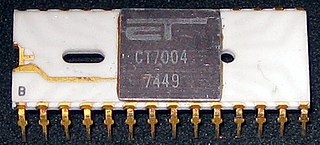
P-type metal-oxide-semiconductor logic uses p-channel metal-oxide-semiconductor field effect transistors (MOSFETs) to implement logic gates and other digital circuits. PMOS transistors operate by creating an inversion layer in an n-type transistor body. This inversion layer, called the p-channel, can conduct holes between p-type "source" and "drain" terminals.
Universal Flash Storage, officially abbreviated as UFS, is a flash storage specification for digital cameras, mobile phones and consumer electronic devices. It aims to bring higher data transfer speed and increased reliability to flash memory storage, while reducing market confusion and removing the need for different adapters for different types of card.
HCMOS is the set of specifications for electrical ratings and characteristics, forming the 74HC00 family, a part of the 7400 series of integrated circuits.

Dr.Vladimír Székely is a Hungarian physicist, professor emeritus at the Budapest University of Technology and Economics and a corresponding member of the Hungarian Academy of Sciences. He was Head of Department of Electron Devices at the Budapest University of Technology and Economics between 1990 and 2005. He has published research results in 360 peer-reviewed papers listed in Web of Science, the most cited being referenced over 200 times, along with 12 books or book-chapters based on his theoretical and practical results.
A level shifter in digital electronics, also called logic-level shifter or voltage level translation, is a circuit used to translate signals from one logic level or voltage domain to another, allowing compatibility between ICs with different voltage requirements, such as TTL and CMOS. Many modern full featured systems use level shifters to bridge domains between processors, logic, sensors, and other circuits. In recent years, the three most common logic levels are 1.8V, 3.3V, 5V, though other levels exist above and below these voltages too.
